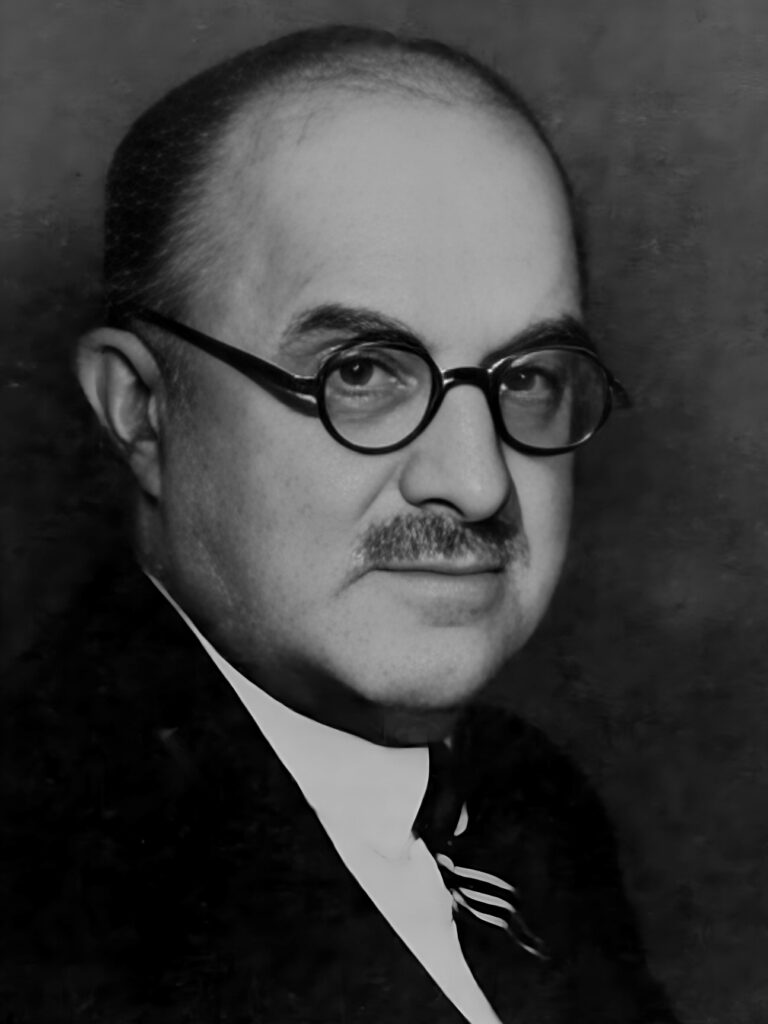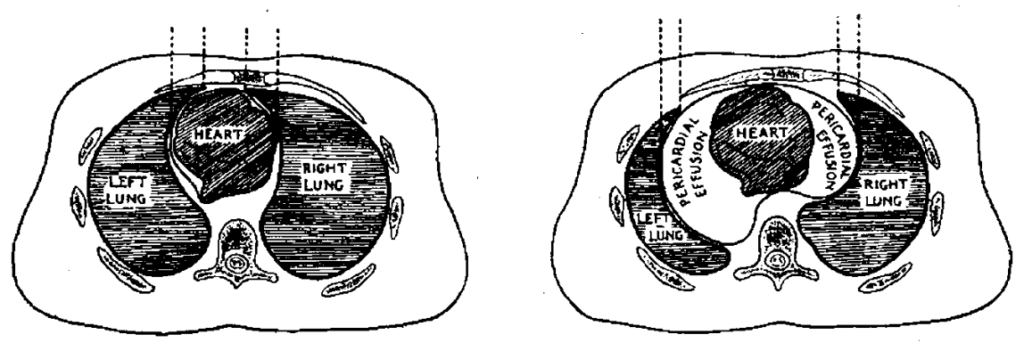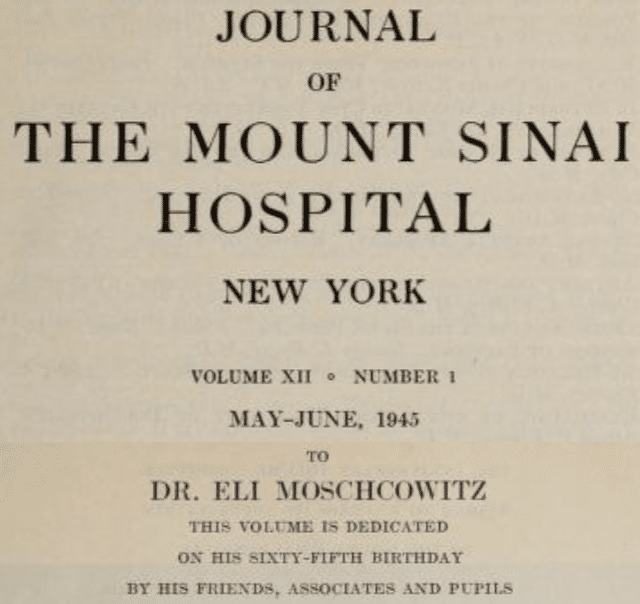Eli Moschcowitz

Eli Moschcowitz (1879-1964) was a Hungarian born, American pathologist and physician.
Moschcowitz was a Hungarian-born American physician and pathologist, best known for his original description of thrombotic thrombocytopaenic purpura (TTP) in 1924—a condition that was long referred to as Moschcowitz syndrome. A distinguished clinician and educator, he held leadership roles at Mount Sinai Hospital and played a significant part in shaping American internal medicine in the first half of the 20th century.
Born on 2 August 1879 in Girált, then part of the Kingdom of Hungary (now Giraltovce, Slovakia), Moschcowitz emigrated to the United States in 1891 with his family. He earned his undergraduate degree from the College of the City of New York and later received his M.D. from Columbia University’s College of Physicians and Surgeons in 1900. He began his career in internal medicine but became deeply involved in pathology and haematology, with a particular interest in systemic diseases with vascular and haematological manifestations.
Moschcowitz’s most enduring contribution came in 1924, when he described a case of a previously unrecognised disorder involving small vessel platelet-rich thrombi leading to petechiae, microangiopathic haemolytic anaemia, and neurological symptoms. He presented this at the New York Pathological Society, and his findings were later published, establishing what would later be called thrombotic thrombocytopaenic purpura (TTP). The syndrome remained poorly understood until the late 20th century, when deficiencies in the enzyme ADAMTS13 were identified as its underlying cause.
Beyond his seminal work on TTP, Moschcowitz was a long-time faculty member at Columbia University and attending physician at Mount Sinai Hospital, New York. He served as President of the American Society for Clinical Investigation in 1929 and was instrumental in advancing clinical-pathological correlation as a central practice in medical education.
He passed away in 1964 at the age of 84.
Biographical Timeline
- 1879 – Born August 2 in Girált, Sáros County, Kingdom of Hungary (now Giraltovce, Slovakia)
- 1891 – Emigrated to the United States with his family
- 1900 – Received M.D. from Columbia University College of Physicians and Surgeons
- 1900s–1920s – Began clinical work and academic affiliation with Mount Sinai Hospital and Columbia University
- 1924 – Described thrombotic thrombocytopaenic purpura (Moschcowitz syndrome) at the New York Pathological Society
- 1929 – Elected President of the American Society for Clinical Investigation
- 1940s–1950s – Continued clinical teaching, research, and departmental leadership
- 1945 – Retired as Director of the Mount Sinai Hospital and Professor of Clinical Medicine at Columbia University College of Physicians and Surgeons
- Died on February 23, 1964
In hospitals, people should be treated and not diseases
Medical Eponyms
Moschcowitz syndrome [Thrombotic thrombocytopenic purpura (TTP)]
Congenital syndrome characterised by thrombocytopenia, purpura, haemolytic anaemia, hyaline thromboses, renal failure and neurological symptoms.
1924 – Moschcowitz reported a 16-year-old girl with petechiae, anaemia, neurological decline, and sudden death. Autopsy revealed small-vessel platelet-rich thrombi, especially in arterioles and capillaries of the brain, heart, and kidneys.
Emanuel Libman (1872–1946) supervised Eli Moschcowitz during his work at Mount Sinai Hospital. In his role as senior clinician/pathologist, Libman was instrumental in shaping the clinical understanding of the publication.
The condition, characterised by thrombocytopaenia, haemolytic anaemia, fever, renal impairment, and neurological symptoms, became known as Moschcowitz syndrome, now recognised as thrombotic thrombocytopaenic purpura (TTP).
Moschcowitz triad (1933)
In his 1933 publication titled “A new sign of pericardial effusion“, he described three physical examination findings that, when present together, are indicative of pericardial effusion:
- Widening of the area of cardiac dullness.
- Abrupt transition from pulmonary resonance to cardiac dullness.
- Extension of cardiac dullness into the second intercostal space
Moschcowitz emphasized that while each sign individually might not be conclusive, their combination provides a reliable diagnostic indicator for pericardial effusion, as confirmed by roentgen examination or autopsy

I have found that the conjunction of three signs is usually conclusive in determining the diagnosis of pericardial effusion; in the order of their importance, they are: (1) widening of the area of cardiac flatness, (2) abrupt transition from pulmonary resonance to cardiac flatness and (3) widening of the cardiac dullness in the second intercostal space. No one of these signs, taken singly, is conclusive, but together they form a triad which is thoroughly reliable, as confirmed by roentgen examination or at autopsy.
Moschcowitz 1933
Moschcowitz sign (1933)
Moschcowitz stated that of these triad of signs signs, only the second had not been described before. When percussing along the right sternal border to determine the overall heart size; dullness along the right sternal border is suggestive of a pericardial effusion or right ventricular enlargement
The abrupt transition of pulmonary resonance to cardiac flatness is due to the practical disappearance of the lung-filled angle between the heart and the anterior wall of the chest owing to the greatly dilated pericardial sac
Moschcowitz 1933
Key Medical Contributions
Moschcowitz and psychosomatic medicine
Eli Moschcowitz was a forerunner in the development of psychosomatic medicine, exploring the links between emotional states and physical illness decades before the biopsychosocial model was formally introduced.
In 1934, Moschcowitz co-authored a paper with Alex Lorand titled “A Psychoanalytic Interpretation of the Constitution in Graves’ Syndrome,” which applied psychoanalytic theory to understand the development of this endocrine disorder.
In his 1935 New England Journal of Medicine article, “The Psychogenic Origin of Organic Diseases“, Moschcowitz argued that emotional and psychological conflict could manifest as organic disease, particularly in the cardiovascular and endocrine systems.
These works positioned Moschcowitz among the early figures advocating for an integrated approach to medicine that considers psychological factors in the diagnosis and treatment of physical illnesses. He viewed the patient as a whole—biologically, psychologically, and sociall. While the term “biopsychosocial model” was later coined by George L. Engel in 1977, Moschcowitz’s contributions significantly influenced the development of this holistic framework
Moschcowitz and Chron’s disease
In 1923 Moschcowitz and Abraham O. Wilensky (1885-1949) detail cases of nonspecific granulomatous inflammation of the intestine, highlighting features such as transmural inflammation, fistula formation, and the absence of caseating necrosis, distinguishing them from tuberculosis.
The lesions were characterized by a chronic inflammatory process involving the entire thickness of the intestinal wall, leading to the formation of strictures and fistulous tracts…In none of our cases was there any evidence of tuberculosis, either clinically or histologically
In 1927 the follow-up article by Moschcowitz and Wilensky presents additional cases and reinforces their earlier observations, further solidifying the concept of a distinct pathological entity. These early descriptions were pivotal in the recognition of a unique form of chronic intestinal inflammation, laying the groundwork for the later characterization of Crohn’s disease.
Major Publications
- Moschowitz E, Wilensky AO. Non-specific granulomata of the intestine. The American Journal of the Medical Sciences 1923; 166: 48-66 [Crohn disease]
- Moschcowitz E. Hyaline thrombosis of the terminal arterioles and capillaries. A hitherto undescribed disease. Proceedings of the New York Pathological Society, 1924; 24: 21-24. [Moschcowitz disease]
- Moschcowitz E. An acute febrile pleiochromic anemia with hyalinethrombosis of the terminal arterioles and capillaries: An undescribed disease. Archives of internal medicine 1925; 36(1): 89–93. [Moschcowitz disease]
- Wilensky AO, Moschowitz E. Non-specific granulomata of the intestine. The American Journal of the Medical Sciences 1927; 173: 374-380 [Crohn disease]
- Moschcowitz E. Hypertension of the pulmonary circulation. American Journal of the Medical Sciences, 1927; 174(3): 388-406.
- Moschcowitz E. Cause of Hypertension of the Greater Circulation. JAMA. 1929; 93(5): 347-351.
- Moschcowitz E. The Cause of Arteriosclerosis. American Journal Of The Medical Sciences. 1929; 178: 244-267
- Moschcowitz E. A new sign of pericardial effusion. JAMA. 1933; 100(21):1663-1664 [Moschcowitz triad]
- Moschcowitz E. A new sign of pericardial effusion. JAMA. 1933; 101(9):727-728
- Lorand A, Moschcowitz E. A Psychoanalytic Interpretation of the Constitution in Graves’ Syndrome. Journal of Nervous and Mental Disease. 1934; 79(2): 136–152.
- Moschcowitz E. The Psychogenic Origin of Organic Diseases. N Engl J Med 1935; 212(14): 603-611
- Moschcowitz E. Recent advances in psychosomatic medicine. Journal of The Mount Sinai Hospital. 1945
- Moschcowitz E. Bibliography, 1945
- Moschcowitz E. Biology Of Disease. 1948

References
Biography
- Dedicated to Eli Moschcowitz on his 65th Birthday. Journal of The Mount Sinai Hospital. 1945
- Portrait: Eli Moschcowitz, MD. Journal of The Mount Sinai Hospital. 1945
- Obituary. Eli Moschcowitz, Internist is dead; Ex-Director at Mt. Sinai Did Work in Psychosomatics. Feb 24, 1964. Ney York Times.
- Klingenstein P. Eli Moschcowitz 1879-1964. Journal of The Mount Sinai Hospital. 1964;
- Obituary. Eli Moschcowitz, MD. Bull Med Libr Assoc. 1965 Apr; 53(2): 302.
- Marcus AJ. Moschcowitz Revisited. N Engl J Med. 1982 Dec 2;307(23):1447-8.
- Aufses AH Jr, Niss BJ. This House of Noble Deeds: The Mount Sinai Hospital, 1852-2002. 2002: 29-32, 289-290
Eponymous terms
- Marcus EL, Steinfeld L. Eli Moschcowitz: A centennial tribute. Am J Med. 1982;72(1):163–164.
- Moake JL. Moschcowitz, multimers, and metalloprotease. N Engl J Med. 1998 Nov 26;339(22):1629-31.
- Lämmle B, Vanhoorelbeke K, Kremer Hovinga JA, Knöbl P. 100 Years of Thrombotic Thrombocytopenic Purpura: A Story of Death and Life. Hamostaseologie. 2024 Feb;44(1):59-73.
- Cataland SR, Coppo P, Scully M, Lämmle B. Thrombotic thrombocytopenic purpura: 100 years of research on Moschcowitz syndrome. Blood. 2024 Sep 12;144(11):1143-1152.
One of the commonest and most pathetic experiences in medical practice is the tragedy of the “successful” man
Eponym
the person behind the name
Dr. Elaine Rabin is an Associate Professor of Emergency Medicine at the Icahn School of Medicine at Mount Sinai, and the Program Director for the Residency in Emergency Medicine at Mount Sinai Hospital | Sinai EM |
BA MA (Oxon) MBChB (Edin) FACEM FFSEM. Emergency physician, Sir Charles Gairdner Hospital. Passion for rugby; medical history; medical education; and asynchronous learning #FOAMed evangelist. Co-founder and CTO of Life in the Fast lane | On Call: Principles and Protocol 4e| Eponyms | Books |

